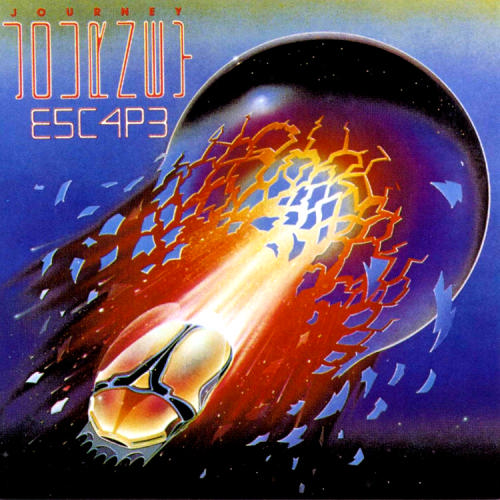
Escape (1981)

1. Don't Stop Believin'
2. Stone in Love
3. Who's Crying Now
4. Keep on Running
5. Still They Ride
6. Escape
7. Lay it Down
8. Dead or Alive
9. Mother, Father
10.Open Arms
Perhaps a more fitting title for this record would have been Explode. The cover image—a gleaming scarab bursting through planetary rings—could remain unchanged. The symbolism fits, after all. With Escape, Journey didn’t just climb the mountain—they launched from it. Yes, the momentum had been building ever since Steve Perry took the reins and shepherded the band toward more accessible terrain. But nothing in their previous ascent quite prepared anyone for the sheer velocity of what came next. This wasn’t just success—it was detonation.
Lineup changes were afoot. Founding keyboardist Gregg Rolie departed following the Departure tour, and in a moment of almost cinematic symmetry, his replacement was Jonathan Cain, keyboardist for The Babys, who had been Journey’s opening act on that very tour. As it turned out, Cain wasn’t just a new hire—he was the missing gene. His fingerprints are everywhere; he co-wrote all ten tracks, and his melodic sensibility added a layer of richness the band hadn’t quite possessed before. Some wagged fingers and muttered “sellout,” but let’s be honest—people had been saying that since 1978. The rock press has always had a complicated relationship with popularity.
And popular this album was. Escape didn’t merely succeed—it defined the AOR genre. It distilled everything fans loved about Journey and presented it in pristine, radio-ready form. The engine, of course, was Perry. His voice—a strange mix of vulnerability and fire—had by now become unmistakable. On this record, it’s given full license to dazzle. While it was already known he could cut through thunderous guitar riffs with surgical precision, Escape showed that Perry could also soothe and seduce. The ballads became the touchstones. Open Arms may have been the sole bona fide power ballad, but tracks like Who's Crying Now, Still They Ride, and the now-immortal Don't Stop Believin' showcased the emotional breadth of his delivery.
Not that the band forgot how to rock. Tracks like Stone in Love and Keep on Runnin' proved they still had teeth. Only Dead or Alive fails to leave much of an impression, and even then, it’s more a shrug than a misstep. One of the album’s more interesting social side effects was its remarkable cross-demographic appeal. In high schools across America, Journey somehow managed to bridge the chasm between the denim-clad disciples of Ozzy and Rush, and the soft-rock faithful spinning Christopher Cross and The Commodores. It was music you could like without apologizing—no matter who you were.
Of course, as with many bands that burn brightest after years of climbing, the top wouldn’t offer much staying power. Internal tensions would begin to fray the fabric not long after, and though there were still a few good records left in the tank, the longevity many fans hoped for wasn’t in the cards. Still, Escape would become the cornerstone of the band’s legacy, and in a twist few could have predicted, Journey would reemerge decades later—buoyed by nostalgia, memes, and karaoke anthems—as eternal icons of an era that refused to fade. Not bad for a band some critics wrote off the moment they found a melody.
Go back to the main page
Go To Next Review